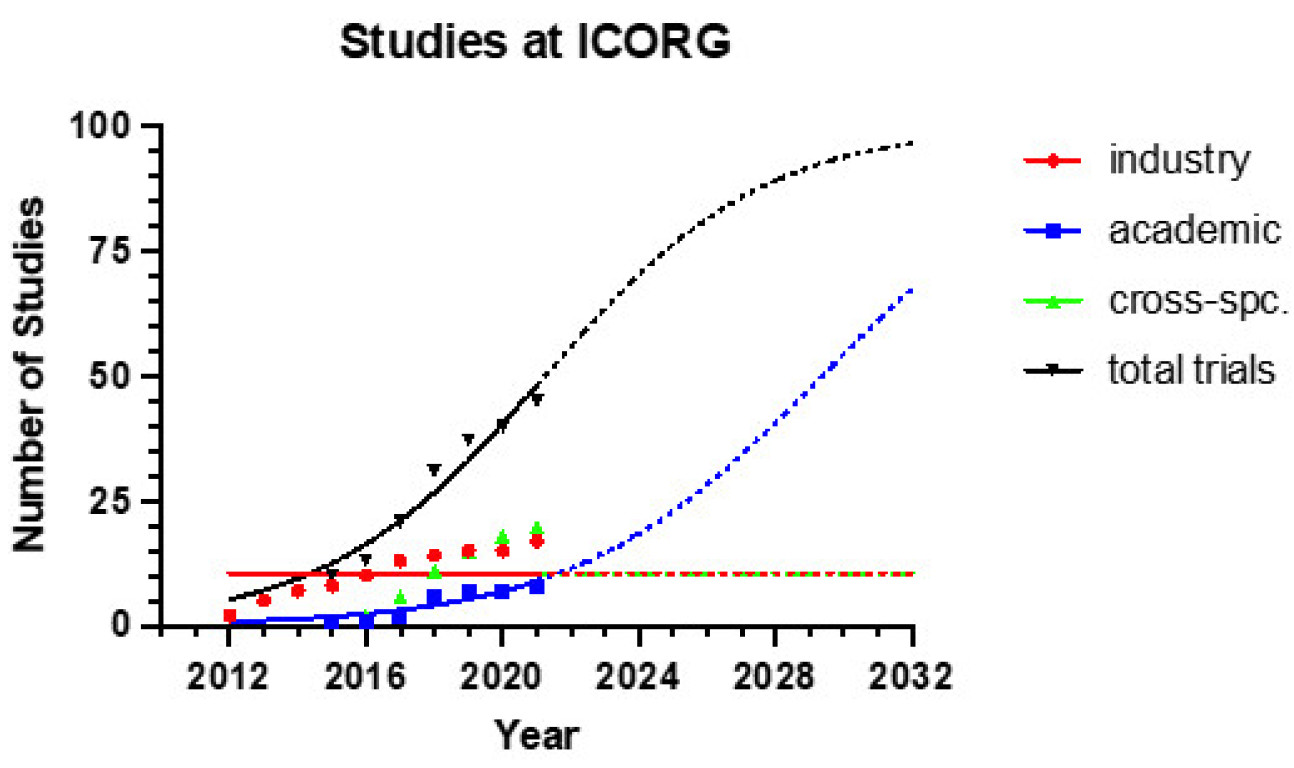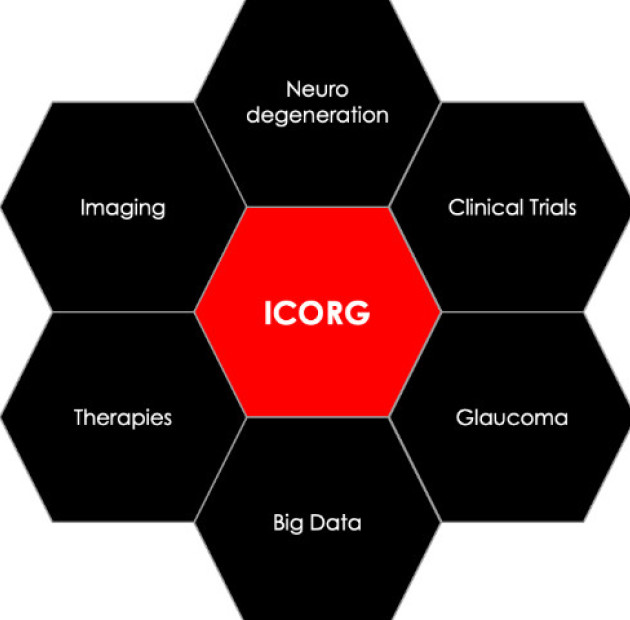What do we do?
We are experts in performing and coordinating innovative research of all phases at Imperial College London and Imperial College Healthcare NHS Trust. We proactively promote multidisciplinary research and eagerly collaborate within the college as well as externally with research centres and institutes.

Contact
Western Eye Hospital
3rd Floor, A&E side
153 - 173 Marylebone Road
London NW1 5QH
+44 (0)20 3312 3206
imperial.icorg@nhs.net
Twitter: @ImperialOph
Serge Miodragovic, ICORG Manager
serge.miodragovic1@nhs.net
News & Events
Aim
Our aim is to optimise the establishment of new diagnostic methods of early disease and identify early markers of cell processes in neurodegenerative disease. We seek opportunities to investigate new therapeutic treatments for ocular diseases, including discovering and developing novel modes of drug delivery and improved treatment strategies.

Why is this important?
Currently in the UK there is estimated to be around 1.58 to 2.31 million people affected with sight-loss and blindness as a result of ocular diseases such as age-related macular degenerative disease (AMD), cataract, diabetic retinopathy and glaucoma. By researching methods of diagnosis and therapeutic treatments we are able to improve patient-care in the community; positively impacting future generations diagnosed with ocular diseases to prevent blindness and avoid disability.
Research areas
- Glaucoma - primary open angle glaucoma (POAG), acute angle glaucoma, ocular hypertension
- Macular - age-related macular degeneration (AMD), diabetic macular oedema (DMO), polypoidal choroidal vasculopathy, macular telangiectasia (MacTel)
- Oculoplastics, vitreoretinal, cataracts, genetic, paediatric
Summary of some of our current research
Summary of some of our current research
Investigator-led
- DARC, PHASE 2 - The DARC Technology (Detection of Ppoptosing Retinal Cells) is a novel technique that utilises the unique optical properties of the eye to allow direct visualisation of retinal nerve cells dying through the process of apoptosis.
- POPPY - Perforated punctal plug as an alternative to the three snip punctoplasty for the treatment of acquired lacrimal punctum.
- LT-ROP - Long-term outcomes in adults with a history of retinopathy of prematurity (ROP)
- WIGS study – the effects of water drinking in patients with open-angle glaucoma
- SUSY – Comparing tissue reactions and scarring with two different types of suture.
- Concept – Comparing the effectiveness of PhacoemulsificatioN + ECP laser and Phacoemulsification alone.
Industry-led
- Thea (IOPtic) - Efficacy and Safety Assessment of T4030 Eye Drops versus Ganfort® UD in Ocular Hypertensive or Glaucomatous Patients
- Catioprost - comparing the efficacy and safety of DE-130A with Xalatan® in Patients with Open-Angle Glaucoma or Ocular Hypertension over a 3-Month period, followed by a 12-Month Follow-Up with Open-Label DE-130A Treatment
- Pulsar – Efficacy and safety of high-dose Aflibercept in patients with neovascular Age-Related Macular Degeneration.
Tabs
Get involved
Patient and Public Involvement
- Imperial College Patient Experience Research Centre (PERC)
- Discover Programme - North West London's health research register
- People in Research - a website for the public to search for opportunities to be involved in research
Support
- Hammersmith & Fulham Sensory Impairment Team
- Sightline Directory - A directory for services aimed at helping blind or partially sighted people.
- Royal National Institute of Blind - UK charity supporting blind and partially sighted people by offering practical and emotional support.
Related Centres
Collaborations
Imperial
- Dr Reza Bahmanyar
- Ms Melanie Corbett
- Ms Laura Crawley
- Mr Graham Duguid
- Ms Rajni Jain
- Professor Chris McCleod
- Dr Richard Nicholas
- Professor Nick Oliver
- Dr Simona Parinella
- Professor Guy Rutter
- Dr Joseph M Sherwood
- Dr Ali Yetisen
UCL
- Dr Satyanarayana Somavarapu
- Professor Matteo Carandini
- Professor Stephen Moss
- Professor Tom Salt
- Professor Frederick Fitzke
- Professor Adam Sillito
- Professor Michael Duchen
- Dr Frances Edwards
- Professor Mike Cheetham
- Professor Christiana Ruhrberg
- Professor Steven Dakin
- Professor David Selwood
- Professor Chris Dainty
- Professor Seb Ourselin
- Dr Jonathan Schott
Global
- Professor Neeraj Agarwal (NEI)
- Professor Francesco Bandello (Milan)
- Professor Alastair Barber (University of Pennsylvania)
- Professor Josef Bille (Heidelberg)
- Professor John Danias (SUNY, New York)
- Dr Fabiana D'Esposito (Naples)
- Professors Crawford Downs and Chris Girkin (Birmingham, Alabama)
- Professor John Flanagan (Waterloo, Canada)
- Professor Stefano Gandolfi (Parma, Italy)
- Professor Tom Gardner (University of Michigan)
- Professor Amiram Grinvald (Tel Aviv)
- Professor Illana Gozes (Tel Aviv)
- Dr Carlo Nucci (Rome)
- Professor Peter Stalmans (University Leuven, Belgium)
- Dr Gerhard Zinser (Heidelberg)
Public Engagement
Media Coverage
- Newsweek - Turmeric could slow vision loss in glaucoma eye drops 25 July 2018
- The Standard - Eye drops made from turmeric could help prevent blindness 23 July 2018
- How funding from charities is fighting glaucoma 12 March 2018
- BBC News - Test may spot glaucoma before symptoms begin, study says 27 April 2017
Past Events
- The 8th Annual ICORG Research Medal and Alumni Meeting Event 28 June 2019
- The Western Eye Ball 2018 Gala Fundraiser 29 June 2018
- BFWI Glaucoma Talk at Grazeley Village Hall, RG7 1LD 27 March 2018
- World Glaucoma Week Free Film Screening: Glances of Closed Eyes 14 March 2018
Our team
Prof M Francesca Cordeiro
/prod01/channel_3/media/migration/faculty-of-medicine/francesca_edit--tojpeg_1521207282219_x4.jpg)
Prof M Francesca Cordeiro
Professor of Ophthalmology, Director of ICORG
Eduardo Maria Normando
/prod01/channel_3/media/migration/faculty-of-medicine/silhouette--tojpeg_1521207477904_x4.jpg)
Eduardo Maria Normando
Clinical Senior Lecturer
Prof Philip Bloom
/prod01/channel_3/media/migration/faculty-of-medicine/silhouette--tojpeg_1523711604537_x4.jpg)
Prof Philip Bloom
Professor of Ophthalmology
Zena Rodrigues
/prod01/channel_3/media/migration/faculty-of-medicine/silhouette--tojpeg_1533136243857_x4.jpg)
Zena Rodrigues
Ophthalmic Nurse Consultant
Fabiana D'Esposito
/prod01/channel_3/media/migration/faculty-of-medicine/silhouette--tojpeg_1540472515780_x4.jpg)
Fabiana D'Esposito
Consultant Ophthalmologist, Genetics
Faisal Ahmed
/prod01/channel_3/media/migration/faculty-of-medicine/profile-photo-2-1_1612260359372_x4.jpg)
Faisal Ahmed
Consultant Ophthalmic Surgeon
Tessa Fayers
/prod01/channel_3/media/migration/faculty-of-medicine/website-tessa--tojpeg_1523973170256_x4.jpg)
Tessa Fayers
Consultant Ophthalmologist
Timothy Edward Yap
/prod01/channel_3/media/migration/faculty-of-medicine/website-tim--tojpeg_1547641421217_x4.jpg)
Timothy Edward Yap
Clinical Research Fellow
Research Areas
Selected Publications
Cordeiro, M. F. (2016) ‘Eyeing the brain’, Acta Neuropathologica. Springer Berlin Heidelberg, 132(6),pp. 765–766. doi: 10.1007/s00401-016-1628-z
Cordeiro, M. F. et al. (2017) ‘Real-time imaging of single neuronal cell apoptosis in patients with glaucoma.’, Brain : a journal of neurology, 140(6), pp. 1757–1767. doi: 10.1093/brain/awx088
Davis, B. M. et al. Topical Curcumin Nanocarriers are Neuroprotective in Eye Disease. Sci. Rep. 8, 11066 (2018). doi: 10.1038/s41598-018-29393-8
De Groef, L. and Cordeiro, M. F. (2018) ‘Is the Eye an Extension of the Brain in Central Nervous System Disease?’, Journal of Ocular Pharmacology and Therapeutics, 34(1–2), pp. 129–133. doi: 10.1089/jop.2016.0180
Normando, E. M. et al. (2016) ‘The retina as an early biomarker of neurodegeneration in a rotenone-induced model of Parkinson’s disease: evidence for a neuroprotective effect of rosiglitazone in the eye and brain’, Acta Neuropathologica Communications, 4(1), p. 86. doi: 10.1186/s40478-016-0346-z
Yap, T., Normando, E.M. & Cordeiro, M.F. (2018) 'Redefining clinical outcomes and endpoints in glaucoma,' Expert Review in Ophthalmology, 13(2), pp. 113-127. doi:10.1080/17469899.2018.1465820 (eprint link)
/prod01/channel_3/media/migration/faculty-of-medicine/Rahila-Zakir--tojpeg_1523718388318_x4.jpg)
/prod01/channel_3/media/migration/faculty-of-medicine/capture-sy_1612262279692_x4.jpg)
/prod01/channel_3/media/migration/faculty-of-medicine/website-ali--tojpeg_1523973100175_x4.jpg)